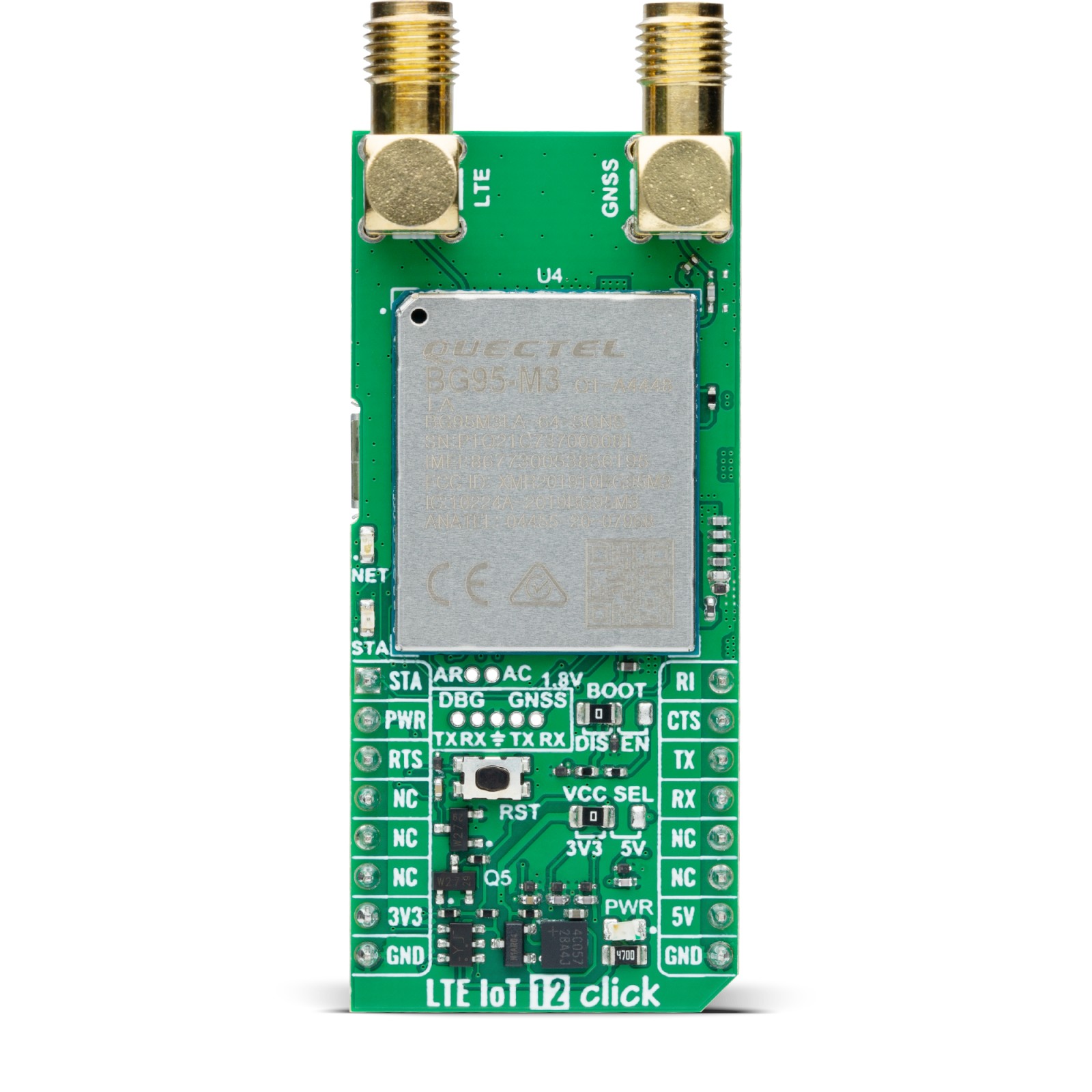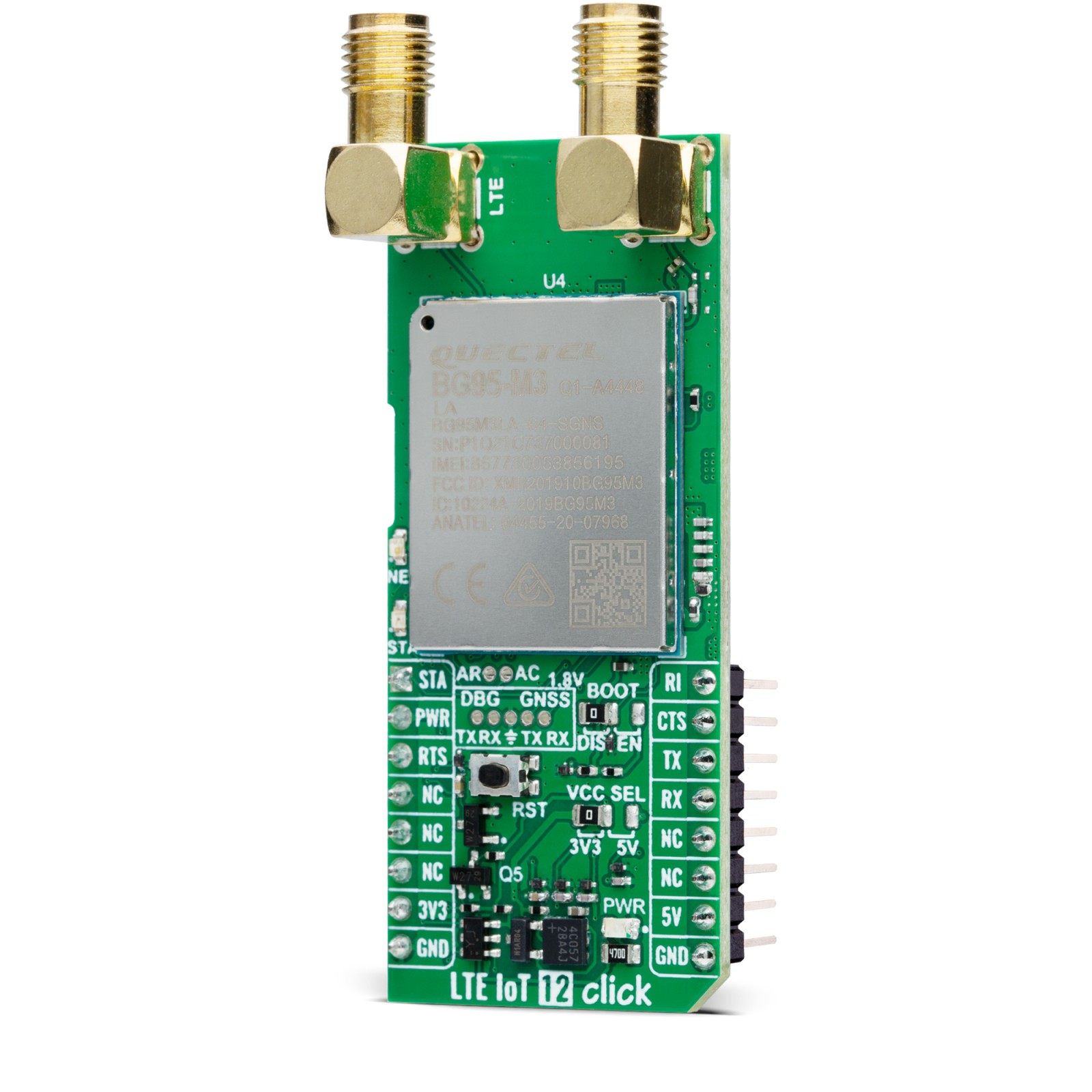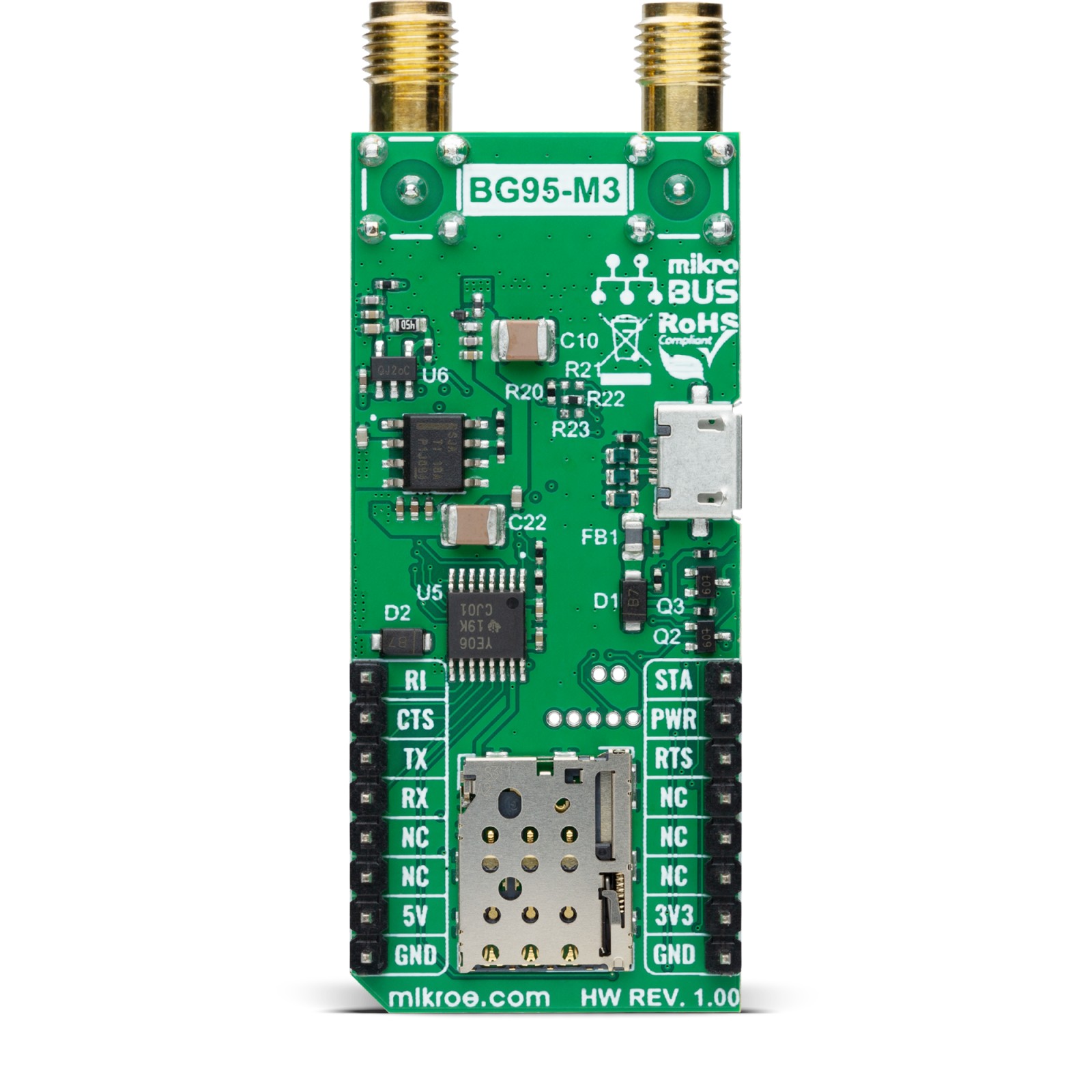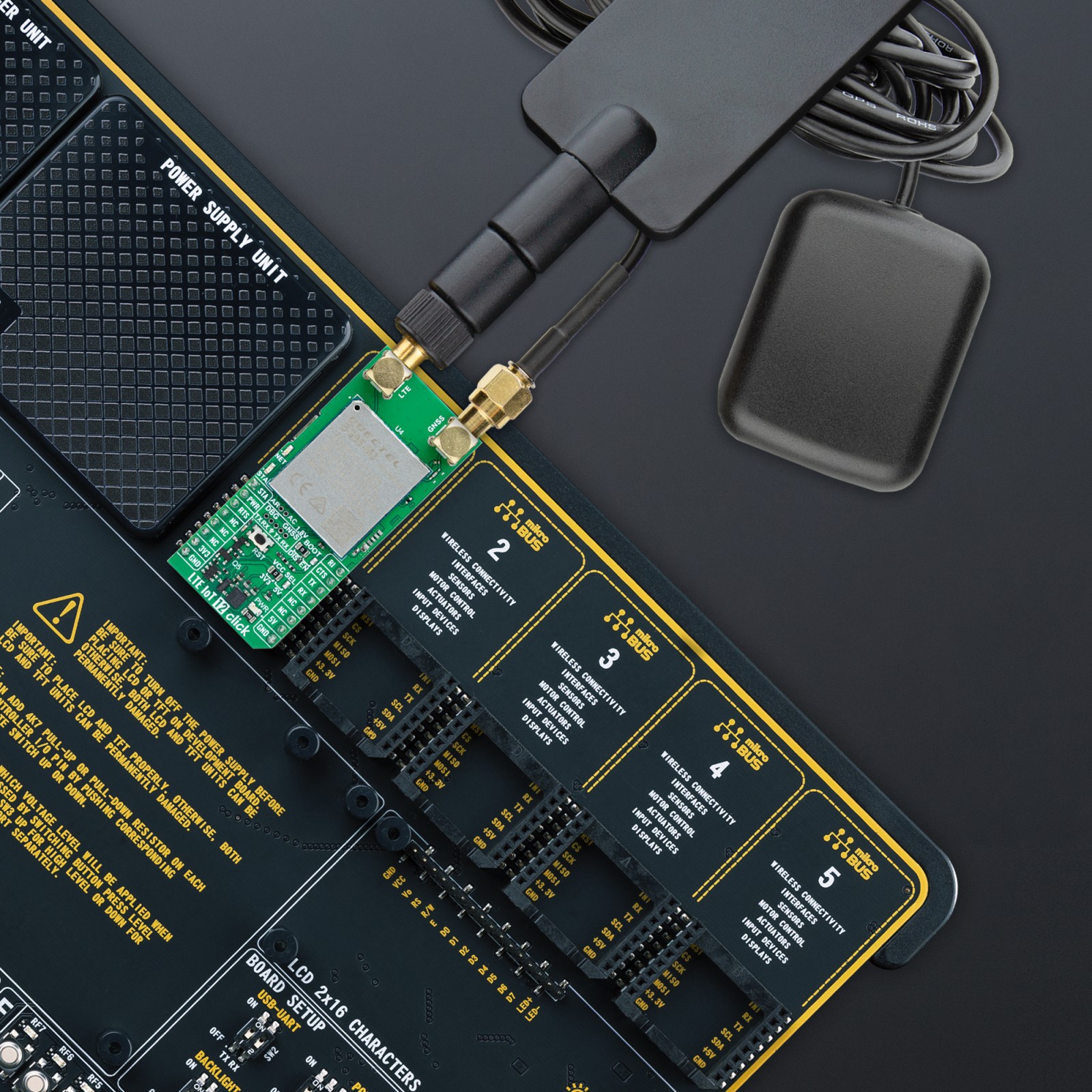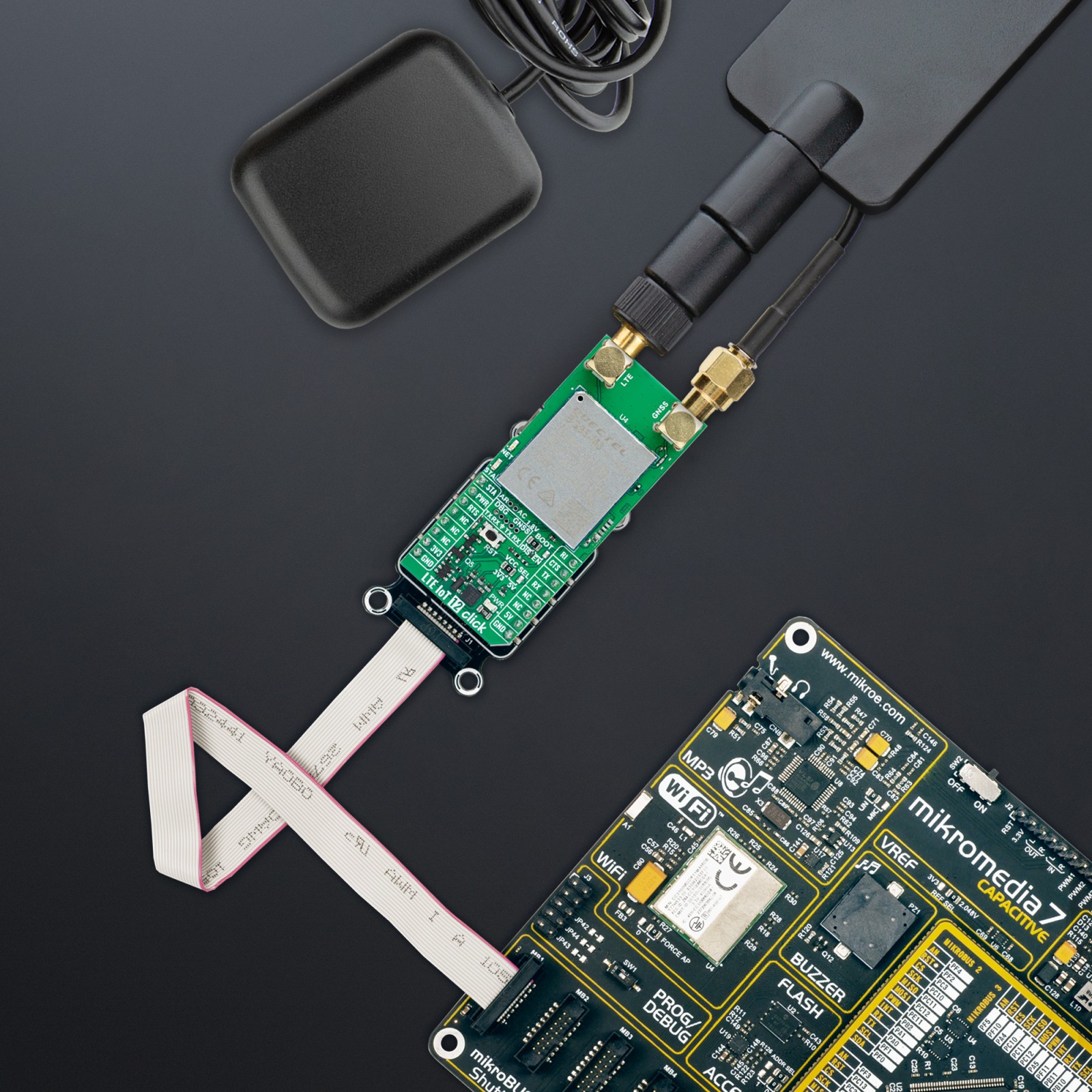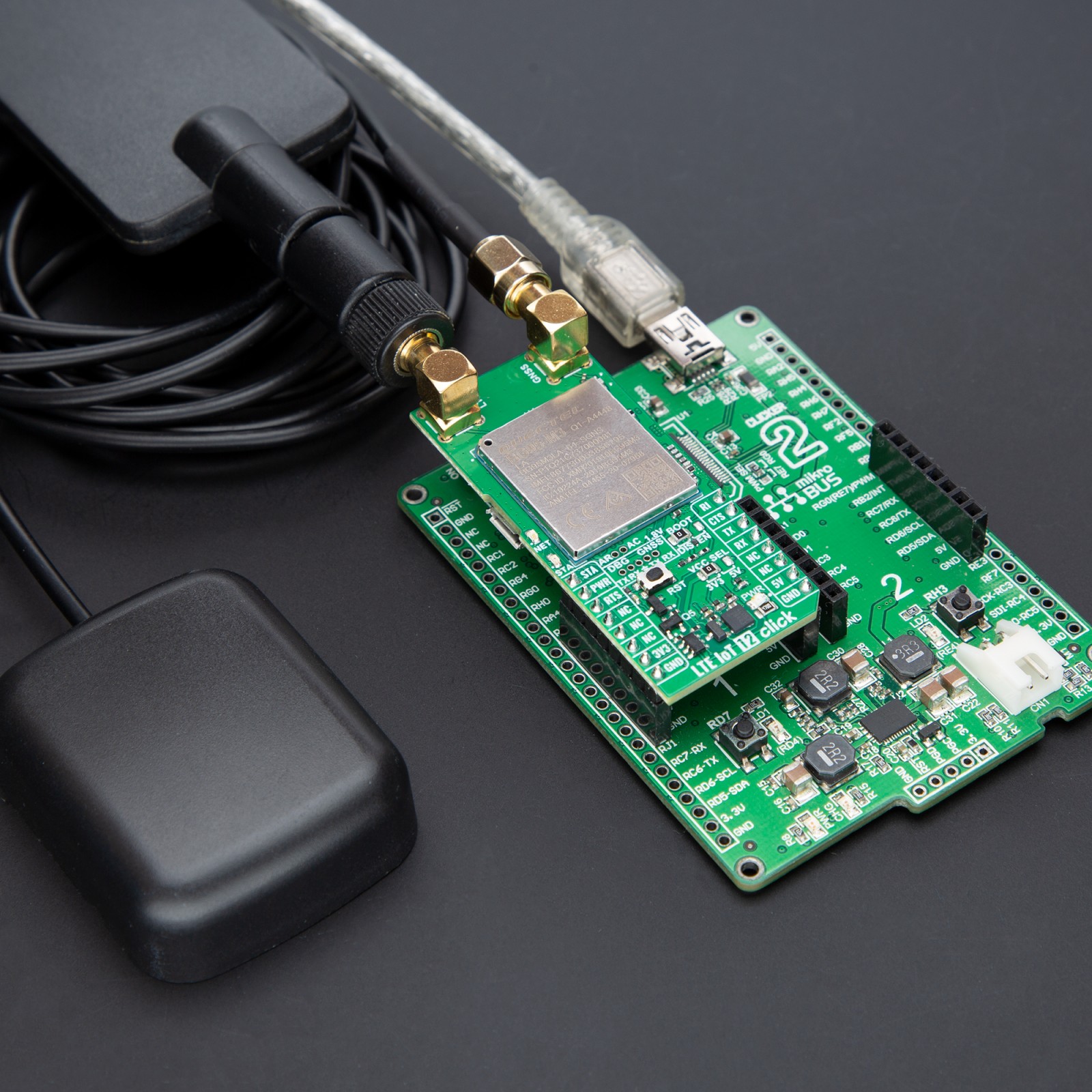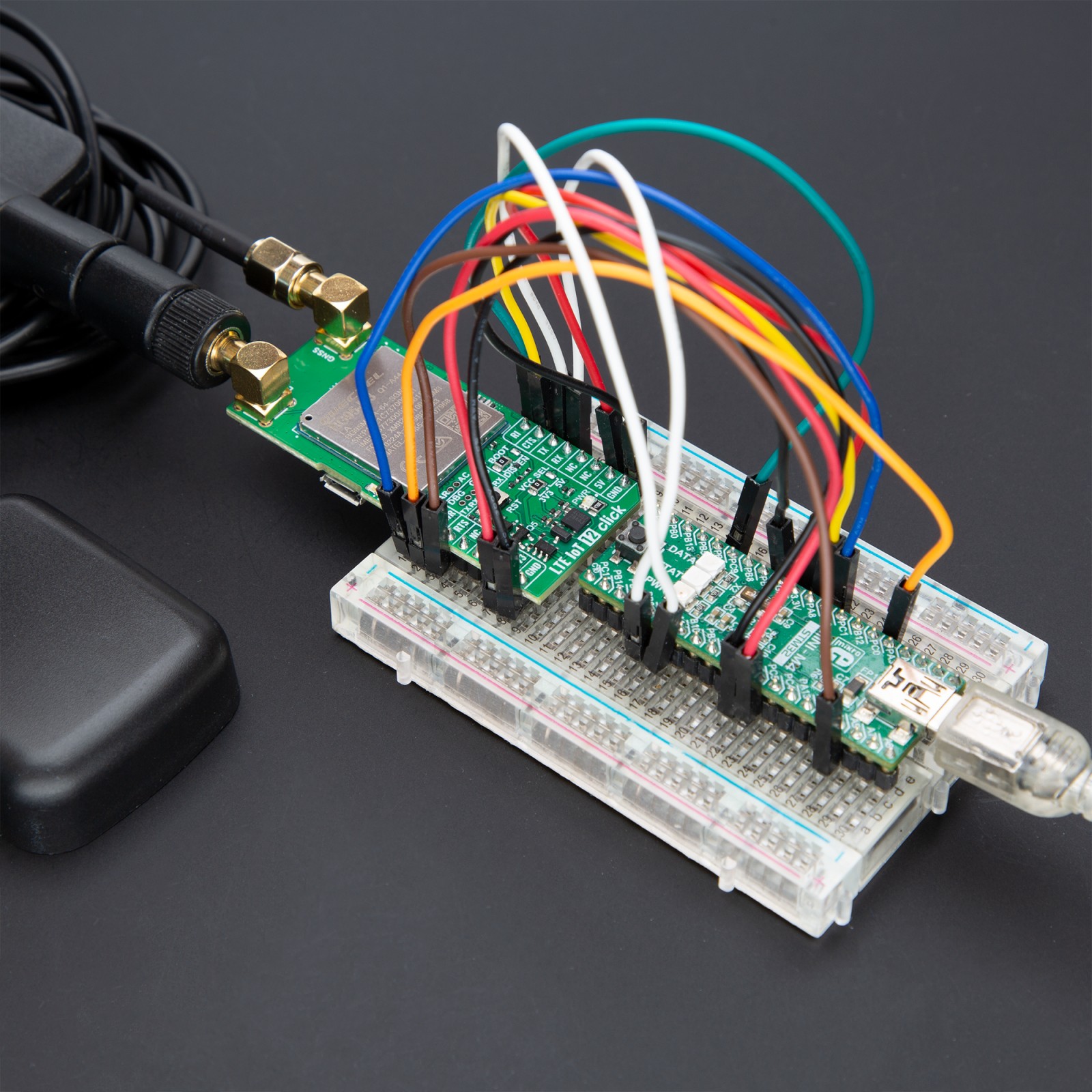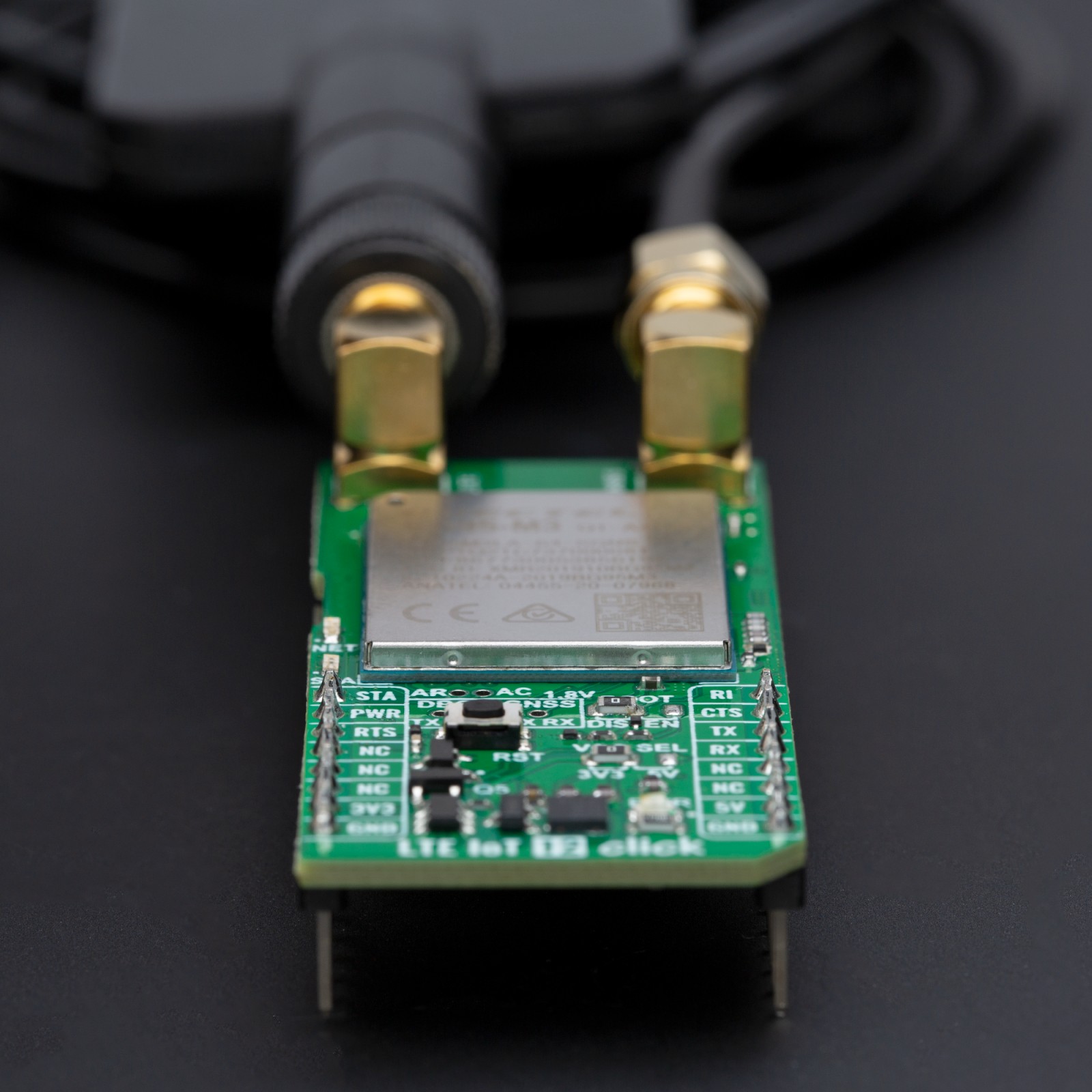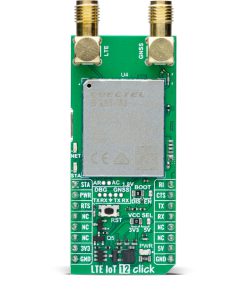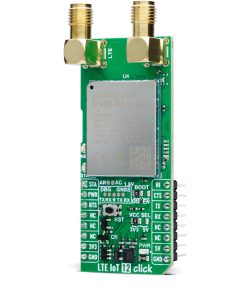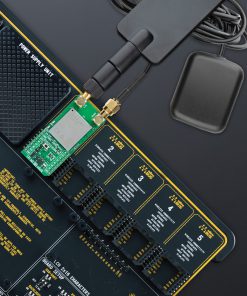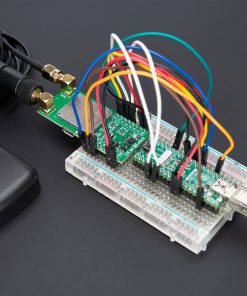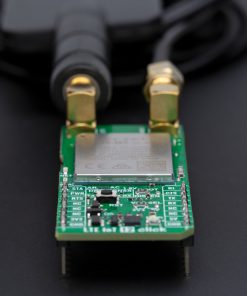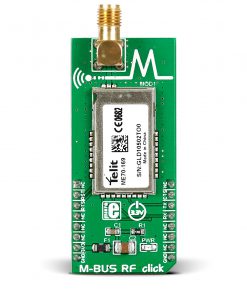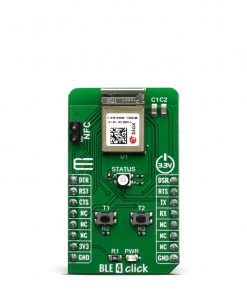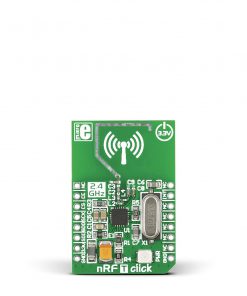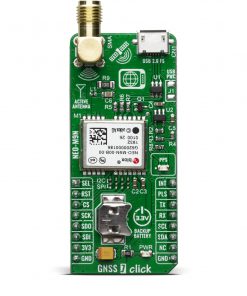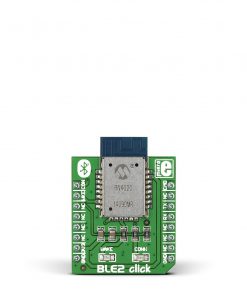LTE IoT 12 Click
R1,550.00 ex. VAT
LTE IoT 12 Click is a compact add-on board designed for low-power LTE Cat M1, NB-IoT, and EGPRS communication in IoT applications. This board features the BG95-M3 multi-mode data-only from Quectel, which also integrates GNSS (GPS, GLONASS, BDS, Galileo, QZSS) for precise location tracking. The board supports a wide range of LTE and 2G bands, offers ultra-low power consumption, and features advanced security via an ARM Cortex A7 processor with TrustZone technology. It includes UART and USB interfaces for easy communication, GNSS data output, and firmware upgrades. This Click board™ is ideal for asset tracking, smart metering, wearable devices, and wireless POS systems applications.
LTE IoT 12 Click is fully compatible with the mikroBUS™ socket and can be used on any host system supporting the mikroBUS™ standard. It comes with the mikroSDK open-source libraries, offering unparalleled flexibility for evaluation and customization. What sets this Click board™ apart is the groundbreaking ClickID feature, enabling your host system to seamlessly and automatically detect and identify this add-on board.
Stock: Lead-time applicable.
| 5+ | R1,472.50 |
| 10+ | R1,395.00 |
| 15+ | R1,317.50 |
| 20+ | R1,267.90 |
How does it work?
LTE IoT 12 Click is based on the BG95-M3 (BG95M3LA-64-SGNS), a multi-mode data-only module from Quectel that supports LTE Cat M1, LTE Cat NB2, and EGPRS technologies, alongside integrated GNSS (GPS, GLONASS, BDS, Galileo, QZSS) for precise location tracking. The BG95-M3 operates on a wide range of LTE bands, including LTE Cat M1 (B1/B2/B3/B4/B5/B8/B12/B13/B18/B19/B20/B25/B26/B27/B28/B66/B85) and LTE Cat NB2 (B1/B2/B3/B4/B5/B8/B12/B13/B18/B19/B20/B25/B28/B66/B71/B85), providing robust coverage and reliable communication. Additionally, the module supports EGPRS on GSM850, EGSM900, DCS1800, and PCS1900 bands, making it backward-compatible with 2G networks where LTE coverage is unavailable. Its compliance with 3GPP Release 14 ensures enhanced connectivity and data rates of up to 588kbps for downlink and 1119kbps for uplink on LTE Cat M1.

This module’s ultra-low power consumption makes it perfect for battery-powered IoT applications. Using its integrated RAM, flash memory, and an ARM Cortex A7 processor running ThreadX, it achieves up to a 70% reduction in PSM (Power Saving Mode) leakage and an 85% reduction in eDRX (Extended Discontinuous Reception) current consumption compared to earlier models. The ARM Cortex A7’s TrustZone engine also ensures robust hardware-based security, supporting secure applications directly on the device. The BG95-M3 supports standard internet service protocols like TCP, UDP, and PPP, controlled via Quectel’s extended AT commands, making it easy to integrate into various applications. A rich set of features, industry-standard interfaces, and abundant functions extend the applicability of the module to a wide range of M2M applications such as wireless POS, smart metering, tracking, wearable devices, and more.
Communication between the BG95-M3 and the host MCU is made through a UART interface, using standard UART RX and TX pins and hardware flow control pins (CTS/RTS/RI – Clear to Send/Ready to Send/Ring Indicator) for efficient data transfer. The module defaults to a communication speed of 115200bps, allowing for seamless data exchange over AT commands. In addition, this Click board™ includes several additional functionalities that enhance its usability and control. The PWR pin of the mikroBUS™ socket allows users to easily power the module ON or OFF, while the RESET button provides a quick way to reset the module.
The board also features two visual indicators to provide real-time status updates. The blue NET LED offers feedback on network activity: it flickers slowly when searching for a network or quickly during data transfer. The green STA LED indicates the module’s power status, which stays off when the module is OFF and turns on when the module is powered ON. The module status is also available over the STA pin of the mikroBUS™ socket.
This Click board™ also offers several additional features to enhance its functionality. It includes a USB interface that complies with the USB 2.0 specification and supports low-speed (1.5 Mbps), full-speed (12 Mbps), and high-speed (480 Mbps) operation. This USB interface can be used for AT command communication, GNSS NMEA sentence output, software debugging, and firmware upgrades. Additionally, the board features a BOOT SEL jumper that forces the module to boot from the USB interface for firmware upgrades when placed in the EN position, with the default position being DIS (disabled).
Furthermore, the board includes two unsoldered UART headers for extended functionality. The first header, DBG, is used for software debugging and log output, while the second header, GNSS, is dedicated to GNSS data output and NMEA sentence streaming. There is also an unsoldered header with AC and AR pins. The AC pin controls one of the module’s operating modes, such as Airplane mode, which turns off all RF functionality and related AT commands. The AR pin serves as a processor-ready indicator, signaling the sleep state of the host MCU.
The board features two SMA connectors for LTE and GNSS antennas that MIKROE offers, like the LTE Flat Rotation Antenna and Active GPS Antenna, for efficient connectivity options. Additionally, the board is equipped with a micro SIM card holder that supports both 1.8V and 3.0V uSIM cards, ensuring compatibility with a wide range of cellular networks and allowing users to select the most appropriate service provider for their particular use case.
This Click board™ can operate with both 3.3V and 5V logic voltage levels selected via the VCC SEL jumper. Since the BG95-M3 module operates at 5V, a logic-level translator, the TXB0106 is also used for proper operation and an accurate signal-level translation. This way, both 3.3V and 5V capable MCUs can use the communication lines properly. Also, this Click board™ comes equipped with a library containing easy-to-use functions and an example code that can be used as a reference for further development.
Specifications
Type
LTE IoT
Applications
Ideal for asset tracking, smart metering, wearable devices, and wireless POS systems applications
On-board modules
BG95-M3 – multi-mode data-only LTE Cat M1/Cat NB2/EGPRS module with integrated GNSS from Quectel
Key Features
Multi-mode LTE Cat M1, Cat NB2, and EGPRS with GNSS, ultra-low power consumption with PSM and eDRX modes, built-in ARM Cortex A7 with TrustZone for secure applications, UART and USB interfaces, TCP, UDP, PPP protocols via AT command, SIM card slot, status indicators, and more
Interface
UART,USB
Feature
ClickID
Compatibility
mikroBUS™
Click board size
L (57.15 x 25.4 mm)
Input Voltage
3.3V or 5V
Pinout diagram
This table shows how the pinout on LTE IoT 12 Click corresponds to the pinout on the mikroBUS™ socket (the latter shown in the two middle columns).
Onboard settings and indicators
| Label | Name | Default | Description |
|---|---|---|---|
| LD1 | PWR | – | Power LED Indicator |
| LD2 | NET | – | Network Status LED Indicator |
| LD3 | STA | – | Module Status LED Indicator |
| JP1 | BOOT | Left | Module Boot Selection DIS/EN: Left position DIS, Right position EN |
| JP2 | VCC SEL | Left | Power Voltage Level Selection 3V3/5V: Left position 3V3, Right position 5V |
| T1 | RESET | – | Reset Button |
LTE IoT 12 Click electrical specifications
| Description | Min | Typ | Max | Unit |
|---|---|---|---|---|
| Supply Voltage | 3.3 | – | 5 | V |
| LTE Operating Frequency | 698 | – | 2180 | MHz |
| GNSS Operating Frequency | 1561 | – | 1697 | MHz |
| LTE Output Power | – | – | +21 | dBm |
| LTE RX Sensitivity | – | -106 | – | dBm |
Software Support
We provide a library for the LTE IoT 12 Click as well as a demo application (example), developed using MIKROE compilers. The demo can run on all the main MIKROE development boards.
Package can be downloaded/installed directly from NECTO Studio Package Manager (recommended), downloaded from our LibStock™ or found on MIKROE github account.
Library Description
This library contains API for LTE IoT 12 Click driver.
Key functions
-
lteiot12_set_sim_apnThis function sets APN for SIM card. -
lteiot12_send_sms_textThis function sends text message to a phone number. -
lteiot12_cmd_runThis function sends a specified command to the click module.
Example Description
Application example shows device capability of connecting to the network and sending SMS or TCP/UDP messages, or retrieving data from GNSS using standard “AT” commands.
void application_task ( void )
{
switch ( app_state )
{
case LTEIOT12_POWER_UP:
{
if ( LTEIOT12_OK == lteiot12_power_up( <eiot12 ) )
{
app_state = LTEIOT12_CONFIG_CONNECTION;
log_printf( &logger, ">>> APP STATE - CONFIG CONNECTION <<<rnn" );
}
break;
}
case LTEIOT12_CONFIG_CONNECTION:
{
if ( LTEIOT12_OK == lteiot12_config_connection( <eiot12 ) )
{
app_state = LTEIOT12_CHECK_CONNECTION;
log_printf( &logger, ">>> APP STATE - CHECK CONNECTION <<<rnn" );
}
break;
}
case LTEIOT12_CHECK_CONNECTION:
{
if ( LTEIOT12_OK == lteiot12_check_connection( <eiot12 ) )
{
app_state = LTEIOT12_CONFIG_EXAMPLE;
log_printf( &logger, ">>> APP STATE - CONFIG EXAMPLE <<<rnn" );
}
break;
}
case LTEIOT12_CONFIG_EXAMPLE:
{
if ( LTEIOT12_OK == lteiot12_config_example( <eiot12 ) )
{
app_state = LTEIOT12_EXAMPLE;
log_printf( &logger, ">>> APP STATE - EXAMPLE <<<rnn" );
}
break;
}
case LTEIOT12_EXAMPLE:
{
lteiot12_example( <eiot12 );
break;
}
default:
{
log_error( &logger, " APP STATE." );
break;
}
}
}
The full application code, and ready to use projects can be installed directly from NECTO Studio Package Manager (recommended), downloaded from our LibStock™ or found on MIKROE github account.
Other MIKROE Libraries used in the example:
- MikroSDK.Board
- MikroSDK.Log
- Click.LTEIoT12
Additional notes and informations
Depending on the development board you are using, you may need USB UART click, USB UART 2 Click or RS232 Click to connect to your PC, for development systems with no UART to USB interface available on the board. UART terminal is available in all MIKROE compilers.
mikroSDK
This Click board™ is supported with mikroSDK – MIKROE Software Development Kit. To ensure proper operation of mikroSDK compliant Click board™ demo applications, mikroSDK should be downloaded from the LibStock and installed for the compiler you are using.
For more information about mikroSDK, visit the official page.
Resources
Downloads
| Weight | 28 g |
|---|---|
| Brand | MikroElektronika |

